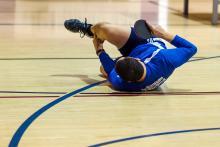The two-wing looper is the most common style in table tennis. This offensive player wins the majority of his points by giving heavy topspins with both backhand and forehand. Check out the 6 keys to keep in mind when devastating this opponent!
#1 Initiate
Against a two-wing looper, it is important to initiate the attack. I often times hear players say, “I gotta stop him from looping.” I reply by saying, “No, that is wrong. You need to initiate the attack.” You see, the best way to stop him from attacking first is by initiating the attack! You can only push short so many times before the ball goes long or high. Initiating a strong attack that is low, deep, with good speed and spin is your best weapon against the two-wing looper. So what are some ways that you can initiate the attack… Attack all serves, loop the long and half-long and flip the short. Serve very low with heavy backspin to make it difficult for the opponent to attack, then initiate after you serve. Attack all flips and pushes. These are the basic ways to initiate.
#2 Details
It might seem like he has a complete game – short serve, short receive, forehand loop, backhand loop, powerful smash… this two-wing looper might seem to have no weak points. However, you must look for details. Ok, he can flip backhand and forehand, however, which one is stronger against which ball. He can loop backhand and forehand, but his backhand loop is significantly weaker after playing a wide forehand. As you can see, the weaknesses might not be super obvious, so you must look for details.
#3 Middle
This is the main tactical point. You must target the middle transition ball about 80% of the time. Table tennis is meant to be played in the automatic stage. When the ball goes to the wide forehand, you automatically play a forehand or backhand then backhand. However, when the ball is coming to the transition point, the player needs to make a conscious decision. What should he do at that moment??? This delay often causes him to be late and lose the timing.
#4 Angles
You want to avoid playing to the corners; however, your two-winged looper is probably used to reaching for some corner balls. If you can play extreme angles, sometimes you might surprise him by playing wider than he is used to. However, targeting the middle is usually better.
#5 Weaknesses
As the match progresses, continue to look for weaknesses. Sometimes a two-wing looper might be swinging fearlessly from both sides. Suddenly at 8-8 in the third game, he becomes a one-wing looper for fear of missing his backhand or might become a blocker or lobber. Continue to re-evaluate.
#6 Transition Balls
Be ready to transition quickly from offense to defense and defense to offense. If you are attacking and your opponent is blocking, he may quickly counterattack. If you are ready for this, you can attack back or make a well placed block. If you are blocking well and get your opponent out of position, you may have the opportunity to take the attack. Always be ready to transition.
In summary, look to initiate the attack, play 80% of the balls to the middle transition point, be ready to transition as the point progresses, and be ready to adjust as the match progresses!
Devastate the Two-Wing Looper

Read 6 Main Keys
Category:



